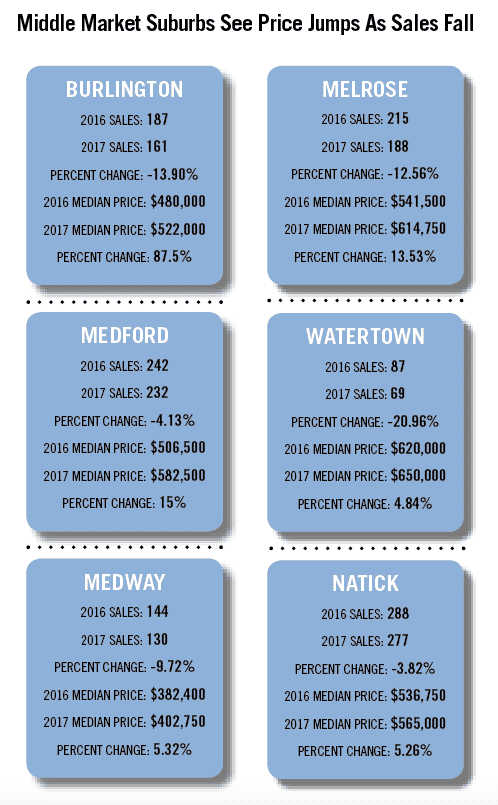Home prices are in overdrive in Greater Boston, but this time the toniest suburbs aren’t leading charge.
Prices have certainly risen to crazy new heights in perennial hot spots like Cambridge, Newton and Wellesley over the past few years, but the pace has slowed as of late, reaching a plateau or maybe even a peak.
But values are soaring in the broad middle of the market, with suburbs ranging from Medway to Wayland seeing high-single digit and even double-digit growth in sale prices accompanied by a drop in numbers of sales, according to statistical analysis from The Warren Group, publisher of Banker & Tradesman.
The combination of rising prices and falling sales is hardly due to any drop in demand, but rather the opposite; buyers are forced to scrap it out over a small and declining number of available homes. The Boston area’s long and increasing dire shortage of housing is taking a toll on the market, with the inventory of unsold homes plunging more than 25 percent in September from a year before, to 2,494, the Greater Boston Association of Realtors reports.
Nowhere can this trend be seen in sharper relief than in Medford, a solid, middle-class community that has seen a big increase in home prices as buyers are squeezed out of far pricier Cambridge and Somerville.
Realtor.com recently blasted out a press release proclaiming Medford the Fourth Hottest ZIP Code in America,” citing a flood of Millennial buyers seeking “relatively affordable suburbs.”
The report cites Medford’s access to public transportation, citing its transformation form a “sleepy city northwest of downtown Boston” to one “now known for its lively dining options, ample recreation opportunities … and the annual Mystic River Celebration devoted to the arts,” gushes the website.
Homes in town are selling in 19 days – far faster than the already low 50-day average for the Boston area – and down by 41 percent compared to last year, according to Realtor.com.
Medford’s median home price jumped to $582,500 during the first nine months of 2017, a 15 percent increase over the same period last year, Warren Group numbers show. Sales have fallen, down to 232 homes sold through September, compared to 242 last year.
Neighboring Melrose, another favorite for refugees from the crazy prices in the Cambridge/Somerville market, has seen almost as big an increase as Medford’s, increasing 13.4 percent to $614,750. Like Medford, the number of homes sold has also dropped, to 188 from 215 a year before. Watertown single-family prices are up $30,000 to $650,000, even as homes sold dropped more than 20 percent, to just 67.
Other once solidly middle-class towns are also moving into uncharted price territory as buyers, often families with children looking for foothold in the Boston area, bid up prices on the relatively small number of homes for sale.
Natick has seen its median price rise nearly $30,000 over the past year to $565,000, even as sales have fallen to 277 from 288 a year ago. (I bought a fixer-upper near Natick Center in 2002 – the median price then was in the $280,000 range.)
Burlington out on Route 128 has seen its median price hit $522,000, up 8.7 percent from last year, when it was $480,000; meanwhile out on 495, Medway has seen its median price top the $400,000 mark after a 5 percent rise and the number of homes sold fell to 130, down from 144 a year before.
Similar trends can be seen in a range of other town ranging from quasi-blue-collar to upper-middle-class aspirants, including Millis, Wayland, Franklin, Stoneham, Sharon, Billerica, Middleton and Norfolk.
If you own a home, this is sort of good news – as long as you are not trying to trade up, a daunting process in this market. But for everyone else, the soaring prices in the middle of the market are yet another warning that the current path we are on in Greater Boston, of strong economic growth and anemic new home construction, just isn’t sustainable.
The last time home prices hit crazy peaks in middle-class towns – in the run-up to the Great Recession – middle-class families starting fleeing the state in droves, leading to a decline in population.
Another year or two of price increases like we are seeing now and you can bet the exodus will start all over again.








